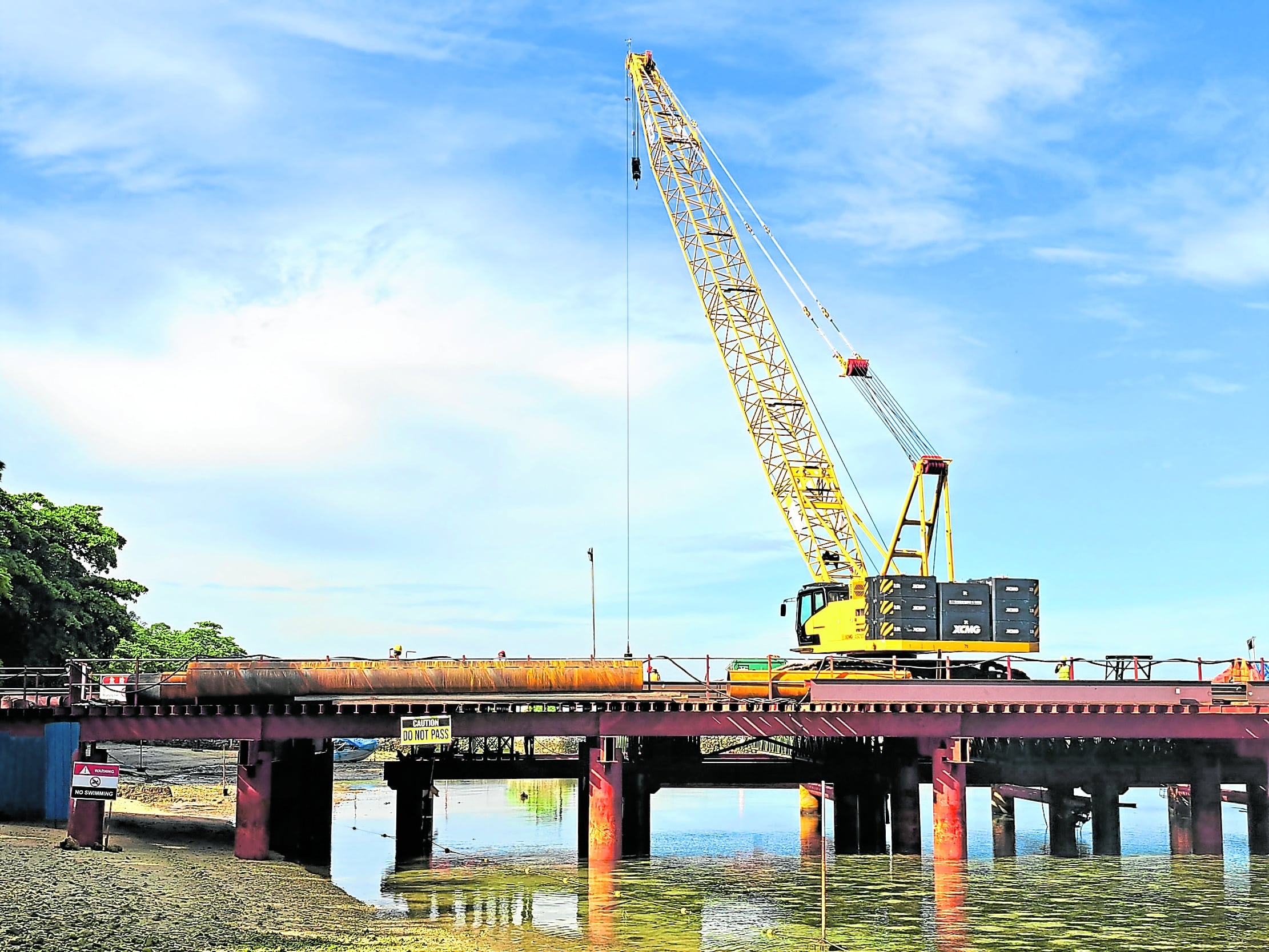Samal-Davao bridge work destroys coral reef, says expert

DEVELOPMENT IMPACT Dead tiered table corals, also knownas centennial table corals (photo taken on Nov. 12), can be seen just 2 meters off the construction site of the craneway that will be used to build the P23-billion Samal Island–Davao City Connector project at the Samal side. —BONG S. SARMIENTO AND JOHN MICHAEL LACSON
DAVAO CITY — Colonies of hard corals in a portion of Davao Gulf are now dead, a situation attributed by a marine scientist to the construction of the Chinese-funded P23-billion bridge called Samal Island–Davao City Connector (SIDC) project.
Marine biologist John Michael Lacson said the destroyed hard corals, including tiered table corals (Acropora hyacinthus), are found near the popular Paradise Beach Resort, a landmark on Samal Island, a key tourist haven in the Davao region.
“These colonies of hard corals adjacent to the craneway preconstructed for the SIDC are now dead because siltation covered them and they are now overgrown with lumot (algae),” Lacson said in a letter to the Paradise Beach Resort management, a copy of which was sent to the Inquirer on Friday.
The dead corals are part of Samal Island’s healthy contiguous reef system called Paradise Reef, which Lacson has been observing in the last 15 years.
On Nov. 7 and Nov. 12, Lacson went underwater to check on the impact of the bridge construction on the corals, and estimated that about 600 square meters of corals–the size of about 10 classrooms–in Paradise Reef are now dead and reduced to rubble.
Article continues after this advertisementIn his letter, dated Nov. 12, Lacson said the corals were covered with silt, which clogged the coral polyps.
“As the coral became stressed, its living tissues died and turned into skeletal fragments (rubble) and the structure became overgrown with algae,” Lacson explained.
Coral polyps are tiny little animals and are related to anemones and jellyfish. They can live individually, or in large colonies that comprise a coral reef, according to global nonprofit Coral Reef Alliance.
Lacson called the destruction of coral colonies in Paradise Reef as “ecological succession,” where a coral reef is succeeded by an algal reef.
READ: PH gets P17.4B Chinese loan for bridge days before Duterte gone
The hard corals, a habitat for fish crucial to the food production and economy of Samal Island, are being destroyed because the SIDC project is not taking steps to protect the environment, he added.
Lacson noted that the Paradise Reef ecosystem is “vital to the survival of coral reef communities fringing Samal Island.”
Appeal
The Department of Public Works and Highways (DPWH) is undertaking the SIDC project. The contract for the design and construction of the bridge was awarded to China Road and Bridge Corp. in January 2021.
SIDC project manager Joweto Tulaylay did not respond when sought for comments on Friday about the impact of the bridge construction to the coral reef system.
READ: Work on Samal-Davao bridge to begin soon, says DPWH
Lacson, in a telephone interview, called on Environment Secretary Maria Antonia Yulo-Loyzaga to act on the destruction wrought by the bridge project to Paradise Reef, a compact coral reef measuring an estimated 1.5 hectares—or at least a third of the Davao City People’s Park—and hosting numerous species of marine life.
The reef system is visible during low tide from the beach resort.
Lacson said he was willing to guide and show the dead corals to personnel of concerned government agencies.
Extent of damage
Last June, the Sustainable Davao Movement, a coalition of environment and civil society groups that opposes the current alignment of the bridge, estimated the damage to corals at 63 square meters, the size of a standard classroom, as the construction for the craneway then went full blast.
The craneway will be used to bring in the materials needed to construct the bridge, which, once completed, will reduce travel time between this city and Samal Island to just five minutes.
Currently, roll-on-roll-off vessels serve the route with a travel time of about 20 minutes. The vehicle queue to board the vessels takes long, sometimes hours, especially during weekends or holidays.
The DPWH’s Environmental Impact Assessment (EIA) report released in July 2020 did not discuss the impact of the offshore construction on the coral reef system but only on the impact on the “seagrass, disruption of fish habitats and disturbance of natural sedimentary habitats on Samal Island.”
The DPWH EIA report was “largely incomplete, misleading, deceptive and highly inaccurate,’’ said marine biologist Filipina Sotto, head of the FBS Environment and Community Research and Development Services team that conducted a study in 2019 commissioned by the Rodriguez-Lucas family.
The Rodriguez-Lucas family owns Paradise Beach Resort and Costa Marina Beach Resort. The bridge is sandwiched between the two resorts.
Sotto and her team had recommended against building the landing site near Paradise Reef as “it will definitely cause irreparable, irreversible and incalculable damage to the best marine ecosystem [on] Samal Island that will have adverse ecological impact to the Davao Gulf as a key marine biodiversity area.”
